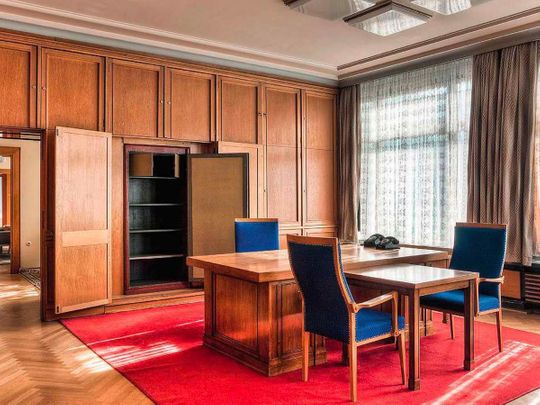
The stamp of the Stasi
A place still in its perfect original condition, as only a week after protesters occupied the premises of the Ministry of State Security of the GDR, it was decided to make this a memorial to Stalinism. The office and home of the Minister of State Security from1957 to 1989, Erich Mielke, exudes the eloquent alchemy of totalitarian design. If it is possible to forget the presence of the room used by the Stasi to extract confessions, the political police working under Communism, it is safe to say that the rest of the furniture, with its convivial and zealous austerity, will be featured some day or another in glossy interior design magazines. Elsewhere, the GDR Museum (German Democratic Republic) offers a meticulous reconstruction of an apartment in the GDR. Ostalgia, a term born after the release of the film Goodbye Lenin defines the wistful nostalgia for old aspects of the former Eastern Germany. Those Ossies who miss the aromas of the Mocca-Fix Cafe, Florena cosmetics and Spreewaldgurken gherkins.
Stasi Museum, Haus1,Ruschestraße, Berlin
GDR Museum, Karl-Liebknecht-Str.1, Berlin
Gourbi chic
This brick-built five-storey building in New York's Lower East Side reveals the ways of life of the immigrants of the New World. Between 1863 and 1935, it would have housed somewhere between 7,000 tenants from over 20 different nations. The Tenement Museum is the work of historians and social activists Ruth Abrams and Anita Jacobson, who discovered this place, frozen in time, in 1988. Restored with amazing attention to detail, such as underwear drying on a line, these walls contained the overcrowded German, Irish and Jewish families that shared this terrifying melting pot of diseases. Despite the dreadful poverty, it is impossible not to feel a certain inspiring charm.
Tenement Museum, 97 Orchard Street, New York
Harsh realities
“Discover the charm of the bygone era of communism!” the slogan on the notice suggests. The Museum of the Popular Republic of Poland (PRL) tells the younger generations all about the harsh realities of the life of their parents during the Communist era. The tiny apartment reveals the remains of Soviet reign under the long shadow of the Iron Curtain. The guide wastes no time in jokingly suggesting that visitors ought to join the Communist Party. But given some of the furtive frowning and face-pulling, nostalgia is clearly no longer what it used to be.
Czar PRL, life under Communism, 25 Minska, Warsaw
In my low-cost social housing
The museum apartment of "Cité Tony-Garnier", bearing the name of this individual who was a key figure in the architectural history of Lyon, recreates the wonderful atmosphere of the period between the two world wars. We have Tony Garnier to thank for the Gerland Stadium and the Town Hall in particular. Located in the eighth district of the former "Capital of the Gauls", this museum apartment comprising just three rooms was designed to accommodate a family of four, and in reality, three generations under the same roof was not unusual. With its star-shaped layout around the “living room”, it is surprisingly modern. Except for the shower, which was nevertheless planned by Tony Garnier, but still has not been installed.
Tony-Garnier Urban Museum, 4 rue des Serpollières, Lyon
Modernist comfort
This home in the centre of Le Havre is a faithful recreation of the original apartment designed by Auguste Perret to rehouse homeless citizens during the bombings of 1944. Thanks to its flexible layout, this revolutionary apartment of 99 m2 contains signature pieces of furniture by René Gabriel or Marcel Gascoin. A double orientation, garbage chute, forced air block heating-all thought out for modern comfort by this master architect of Le Corbusier. Elegant detail that even goes as far as the adorable embroidered linen on the child's bed. You would sign the lease without hesitation.
Appartement Perret, 181 rue de Paris, Le Havre


